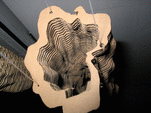The cost of "fabbing" or digital fabrication, a printing process that allows people to manufacture 3D objects with laser technology, has slowly fallen within the past few years, inviting speculation that it could possibly be used in the commercial market. Digital fabricators are incredibly versatile tools, applicable to a range of materials, including ceramic, cardboard, plaster- and, techniques, such as milling, forming, building. The group exhibition "Beyond the Screen", which opened over the weekend at [DAM] Berlin, explores digital fabrication's artistic applications in light of the increasing availability and flexibility of these machines. Organized by Marius Watz's ongoing curatorial project for generative strategies in art, Generator.x, the show is one part of DAM Berlin’s larger program on fabbing for Club Transmediale, which includes performances and a workshop. The participants in the exhibition operate between the fields of architecture, design, and art, yet share a practice of using digital fabrication to render complex computationally derived forms into tangible sculptures. True to its name, "Beyond the Screen" features works by a selection of artists who view code as a building block for concrete sculpture. Architects Marc Fornes (theverymany) and Skylar Tibbits collaborated on the installation Aperiodic Vertebrae (2008). An assembly of triangular shapes, the overall structure resembles the dismantled skeleton of a reptilian dinosaur. The form comes out of experimentations with generative geometry in the program Rhino3D, a popular scripting tool used by architects. Artist Jared Tarbell, who recently turned to laser cutting to realize his 2D work in a physical format, produced varying sized cubes with cut out circular flourishes, which he then displayed with loose floral pieces. Interactive design studio TODO hung a delicate quilt of perforated bulbous shapes in the space, whose contours gradually thinned from top to bottom. While currently the applications for digital fabrication may seem beyond the technical and financial bounds of the everyday tinkerer, some posit that the technology will become a household staple in the near future, eventually allowing the general public to circumvent traditional manufacturing, transforming the garage into a veritable factory for creation. - Ceci Moss
Image: Leander Herzog, thePhysicalVertexBuffer, 2007
